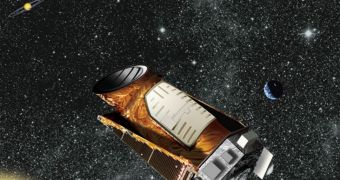Experts at the NASA Jet Propulsion Laboratory (JPL), in Pasadena, California, announce the “birthday” of the American space agency's most advanced planet-hunting telescope. Launched one year ago this week, the Kepler Telescope took off from Space Launch Complex 17-B at the Cape Canaveral Air Force Station (CCAFS), in Florida, on March 7, 2009. Its primary mission is to facilitate the discovery of small, Earth-like exoplanets orbiting other stars. This objective is extremely important in our quest to understand what makes a world habitable, as well as for determining whether we are alone in the Universe or not.
The mission did not always perform according to plan, with several glitches delaying some of the basic observations that the telescope was planned to perform. But none of these malfunctions affected the observatory's ability to produce amazing scientific results permanently. This was made obvious not two months ago, when mission controllers were happy to announce that readings captured hints of five very large exoplanets, Kepler 4b, 5b, 6b, 7b and 8b, which were later on confirmed using other telescopes.
Its instrument payload consists of a single photometer, a Schmidt telescope design with a 0.95-meter aperture, and a 105 square degree (about 12 degree diameter) field-of-view (FOV). It is capable of observing the Universe in wavelengths ranging from 400 to 850 nanometers, and thus far it appears to be fairly good at it. The telescope is not in orbit around our planet, but in an Earth-trailing orbit around the Sun. Mission planners selected this position so that stray light coming from the planet doesn't interfere with its highly-delicate instruments.
“The photometer is composed of just one 'instrument,' which is, an array of 42 CCD (charge coupled devices). Each 50x25 mm CCD has 2200x1024 pixels. The CCD are read out every three seconds to prevent saturation. Only the information from the CCD pixels where there are stars brighter than about R magnitude of 16 is recorded. (The CCD are not used to take pictures. The images are intentionally defocused to 10 arc seconds to improve the photometric precision.) The data are integrated for 30 minutes,” NASA scientists say in a brief presentation of the instrument.
“The Kepler Mission is designed to observe more than 150,000 stars continuously and simultaneously for signs of Earth-size planets until at least November 2012. Some of the planets are expected to orbit in a star's 'habitable zone,' a warm region where liquid water could pool on the surface,” the JPL group adds in a post on their official website.

 14 DAY TRIAL //
14 DAY TRIAL //